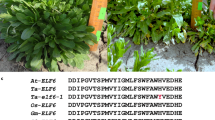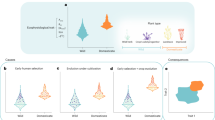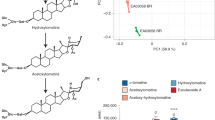Abstract
Among major cereals domesticated as staple food, only sorghum has a high proportion of cultivars with condensed tannins in grain, which can trigger bitter taste perception in animals by binding to type 2 taste receptors (TAS2Rs). Here, we report the completion of uncovering of a pair of duplicate recessive genes (Tannin1 and Tannin2) underlying tannin presence. Three loss-of-function alleles from each gene were identified in non-tannin sorghum desired as palatable food. Condensed tannins effectively prevented sparrows from consuming sorghum grain. Parallel geographic distributions between tannin sorghum and Quelea quelea supported the role of tannins in fighting against this major herbivore threat. Association between geographic distributions of human TAS2R variants and tannin sorghum across Africa suggested that different causes had probably driven this bidirectional selection according to varied local herbivore threats and human taste sensitivity. Our investigation uncovered coevolution among humans, plants and environments linked by allelochemicals.
This is a preview of subscription content, access via your institution
Access options
Access Nature and 54 other Nature Portfolio journals
Get Nature+, our best-value online-access subscription
$29.99 / 30 days
cancel any time
Subscribe to this journal
Receive 12 digital issues and online access to articles
$119.00 per year
only $9.92 per issue
Buy this article
- Purchase on Springer Link
- Instant access to full article PDF
Prices may be subject to local taxes which are calculated during checkout




Similar content being viewed by others
Data availability
Information on tannin presence, indicated by the pigmented testa layer, of 11,557 sorghum accessions collected from Africa was retrieved from the USDA GRIN database (https://npgsweb.ars-grin.gov/gringlobal/descriptors.aspx) by querying ‘testa’ in morphological descriptors under ‘sorghum’ crop. The geographic distribution of Q. quelea was requested through BirdLife (http://datazone.birdlife.org/species/requestdis). Sorghum growing area in Africa was accessed at HarvestChoice (https://harvestchoice.org/maps/sorghum-rainfed-yield-kgha-2000).
References
Willis, R. J. The History of Allelopathy (Springer Science & Business Media, 2007).
Johns, T. The Origins of Human Diet and Medicine: Chemical Ecology (Univ. Arizona Press, 1996).
Drewnowski, A. & Gomez-Carneros, C. Bitter taste, phytonutrients, and the consumer: a review. Am. J. Clin. Nutr. 72, 1424–1435 (2000).
Luca, F., Perry, G. H. & Di Rienzo, A. Evolutionary adaptations to dietary changes. Annu. Rev. Nutr. 30, 291–314 (2010).
Meyer, R. S. & Purugganan, M. D. Evolution of crop species: genetics of domestication and diversification. Nat. Rev. Genet. 14, 840–852 (2013).
Dykes, L. & Rooney, L. W. Phenolic compounds in cereal grains and their health benefits. Cereal Foods World 52, 105–111 (2007).
Jackson, F. L. C. Secondary compounds in plants (allelochemicals) as promoters of human biological variability. Annu. Rev. Anthropol. 20, 505–546 (1991).
Harris, D. R. & Hillman, G. in Foraging and Farming: The Evolution of Plant Exploitation (eds Harris, D. R. & Hillman, G.C.) 11–26 (Routledge, 1989).
Smith, C. W. & Frederiksen, R. A. Sorghum: Origin, History, Technology, and Production (John Wiley & Sons, 2000).
Wu, Y. et al. Presence of tannins in sorghum grains is conditioned by different natural alleles of Tannin1. Proc. Natl Acad. Sci. USA 109, 10281–10286 (2012).
Li, X., Li, X., Fridman, E., Tesso, T. T. & Yu, J. Dissecting repulsion linkage in the dwarfing gene Dw3 region for sorghum plant height provides insights into heterosis. Proc. Natl Acad. Sci. USA 112, 11823–11828 (2015).
Awika, J. M. & Rooney, L. W. Sorghum phytochemicals and their potential impact on human health. Phytochemistry 65, 1199–1221 (2004).
Sturkie, P. D. Avian Physiology (Springer Science & Business Media, 2012).
Davis, J. K. et al. Evolution of a bitter taste receptor gene cluster in a New World sparrow. Genome Biol. Evol. 2, 358–370 (2010).
Nesi, N. et al. The TT8 gene encodes a basic helix–loop–helix domain protein required for expression of DFR and BAN genes in Arabidopsis siliques. Plant Cell 12, 1863–1878 (2000).
Sweeney, M. T., Thomson, M. J., Pfeil, B. E. & McCouch, S. Caught red-handed: Rc encodes a basic helix–loop–helix protein conditioning red pericarp in rice. Plant Cell 18, 283–294 (2006).
Burr, F. A. et al. The maize repressor-like gene intensifier1 shares homology with the r1/b1 multigene family of transcription factors and exhibits missplicing. Plant Cell 8, 1249–1259 (1996).
Yu, X. et al. Genomic prediction contributing to a promising global strategy to turbocharge gene banks. Nat. Plants 2, 16150 (2016).
Yano, K. et al. Genome-wide association study using whole-genome sequencing rapidly identifies new genes influencing agronomic traits in rice. Nat. Genet. 48, 927–934 (2016).
Lin, Z. et al. Parallel domestication of the Shattering1 genes in cereals. Nat. Genet. 44, 720–724 (2012).
Lasky, J. R. et al. Genome–environment associations in sorghum landraces predict adaptive traits. Sci. Adv. 1, e1400218 (2015).
Shefte, N., Bruggers, R. & Schafer, E. Repellency and toxicity of three bird control chemicals to four species of African grain-eating birds. J. Wildlife Manage. 46, 453–457 (1982).
Council, N. R. Lost Crops of Africa Vol. 1 (National Academies Press, 1996).
Manikowski, S. & Dacamarasmeets, M. Estimating bird damage to sorghum and millet in Chad. J .Wildlife Manage. 43, 540–544 (1979).
Bullard, R. & Elias, D. (ed. Hulse, J.) Sorghum polyphenols and bird resistance. In Polyphenols in Cereals and Legumes: Proc. Symposium (IDRC, 1979).
Mofokeng, M. & Shargie, N. Bird damage and control strategies in grain sorghum produciton. Int. J. Agric. Environ. Res. 2, 264–269 (2016).
Bullard, R. W., Garrison, M. V., Kilburn, S. R. & York, J. O. Laboratory comparisons of polyphenols and their repellent characteristics in bird-resistant sorghum grains. J. Agric. Food Chem. 28, 1006–1011 (1980).
Mace, E. S. et al. Whole-genome sequencing reveals untapped genetic potential in Africa’s indigenous cereal crop sorghum. Nat. Commun. 4, 2320 (2013).
Guo, H. et al. Gene duplication and genetic innovation in cereal genomes. Genome Res. 29, 261–269 (2019).
Kuroha, T. et al. Ethylene–gibberellin signaling underlies adaptation of rice to periodic flooding. Science 361, 181–186 (2018).
Campbell, M. C. et al. Origin and differential selection of allelic variation at TAS2R16 associated with salicin bitter taste sensitivity in Africa. Mol. Biol. Evol. 31, 288–302 (2014).
Kobue‐Lekalake, R. I., Taylor, J. R. & de Kock, H. L. Influence of PROP taster status on the consumer acceptability of food made from tannin sorghums. J. Sci. Food Agric. 89, 1809–1814 (2009).
Soares, S. et al. Different phenolic compounds activate distinct human bitter taste receptors. J. Agric. Food Chem. 61, 1525–1533 (2013).
Soares, S. et al. Human bitter taste receptors are activated by different classes of polyphenols. J. Agric. Food Chem. 66, 8814–8823 (2018).
Hayes, J. E. et al. Allelic variation in TAS2R bitter receptor genes associates with variation in sensations from and ingestive behaviors toward common bitter beverages in adults. Chem. Senses 36, 311–319 (2011).
Gu, X. Y. et al. Association between seed dormancy and pericarp color is controlled by a pleiotropic gene that regulates abscisic acid and flavonoid synthesis in weedy red rice. Genetics 189, 1515–1524 (2011).
Hufford, M. B., Berny Mier, Y. T. J. C. & Gepts, P. Crop biodiversity: an unfinished magnum opus of nature. Annu. Rev. Plant Biol. 70, 727–751 (2019).
Gepts, P. in Plant Breeding Rev. Vol. 24 (ed. Janick, J.) 1–44 (John Wiley & Sons, 2004)..
Gelli, M. et al. Validation of QTL mapping and transcriptome profiling for identification of candidate genes associated with nitrogen stress tolerance in sorghum. BMC Plant Biol. 17, 123 (2017).
Wang, S. Windows QTL cartographer v.2.5 (North Carolina State Univ. 2007).
Li, H., Ribaut, J. M., Li, Z. & Wang, J. Inclusive composite interval mapping (ICIM) for digenic epistasis of quantitative traits in biparental populations. Theor. Appl. Genet. 116, 243–260 (2008).
Lipka, A. E. et al. GAPIT: genome association and prediction integrated tool. Bioinformatics 28, 2397–2399 (2012).
Morris, G. P. et al. Dissecting genome-wide association signals for loss-of-function phenotypes in sorghum flavonoid pigmentation traits. G3 (Bethesda) 3, 2085–2094 (2013).
Danecek, P. et al. The variant call format and VCFtools. Bioinformatics 27, 2156–2158 (2011).
Hollfelder, N. et al. Northeast African genomic variation shaped by the continuity of indigenous groups and Eurasian migrations. PLoS Genet. 13, e1006976 (2017).
Uren, C. et al. Fine-scale human population structure in southern Africa reflects ecogeographic boundaries. Genetics 204, 303–314 (2016).
Patin, E. et al. Dispersals and genetic adaptation of Bantu-speaking populations in Africa and North America. Science 356, 543–546 (2017).
Schlebusch, C. M. et al. Genomic variation in seven Khoe-San groups reveals adaptation and complex African history. Science 338, 374–379 (2012).
Busby, G. B. et al. Admixture into and within sub-Saharan Africa. eLife 5, e15266 (2016).
Acknowledgements
We thank D. Pinnow for assistance with the sorghum seed bleach experiment. This work was supported by the Agriculture and Food Research Initiative competitive grants (nos. 2017-67007-25942 and 2011-67009-30614) from the USDA National Institute of Food and Agriculture, the National Science Foundation (grant no. IOS-1238142), the National Natural Science Foundation of China (grant no. 31871695), the Iowa State University Raymond F. Baker Center for Plant Breeding and the Iowa State University Plant Sciences Institute.
Author information
Authors and Affiliations
Contributions
J.Y. and Xia.Li designed the research. Yuy.Wu, T.G., Q.M, J.W., Xin Li, Yun Wu., M.L.W., B.T., J.Y. and Xia.Li conducted the experiments. G.B., R.P., H.N.T., S.R.B., I.M.D., M.R.T., G.M. and T.T.T contributed materials and analysis tools. Yuy.Wu, J.Y. and Xia.Li wrote the manuscript with input from all authors.
Corresponding authors
Ethics declarations
Competing interests
The authors declare no competing interests.
Additional information
Peer review information Nature Plants thanks Peter Civan, Song Ge, Ya-Long Guo, Tian Tang and the other, anonymous, reviewer(s) for their contribution to the peer review of this work.
Publisher’s note Springer Nature remains neutral with regard to jurisdictional claims in published maps and institutional affiliations.
Extended data
Extended Data Fig. 1 The sorghum field where the flock of sparrows inhabited.
a, Aerial view of the sorghum filed (half). The image was taken from an unmanned aerial vehicle. b, 3D-reconstuctured point cloud of the whole field. c, Relative plant height profile along the magenta band in b. The red and white arrows indicate the tall and leafy biomass sorghum plants forming the field border and the yellow arrows indicate the empty alley.
Extended Data Fig. 2 Yield loss attributed to sparrow damage.
a, Five panicle from midly (left) and heavily damaged (right) RILs. b, 341 grams of seeds from 5 mildly damaged panicles v.s.15 grams of residue grain from 5 heavily damaged panicles.
Extended Data Fig. 3 Tannin presence and plant height contribute to sparrow feeding preferences.
a, Overall relationships among three traits scored from the Tx430 × P898012 RIL population. Each dot represents a RIL. Bird damage score is used to colour code each data point. b, Distribution of bird damage score based on RILs with (n = 67) or without (n = 167) condensed tannins in grain. Boxplots contain the extreme of the lower whisker, the lower hinge, the median, the upper hinge, and the extreme of the upper whisker for each category. c, For RILs without condensed tannins (n = 167), plant height was positively correlated (Pearson’s correlation) with sparrow feeding preference. d, For RILs with condensed tannins (n = 67), plant height has less effect on sparrow feeding preference. e, QTL mapping for bird damage (n = 237). f, QTL mapping for plant height (n = 237).
Extended Data Fig. 4 The pigmented testa layer is absent in seeds from heavily damaged sorghum.
a, b, Longitudinal sections of intact seeds from a RIL heavily damaged (left) and a RIL mildly damaged (right) by the sparrows. c, d, Bleach stained longitudinal sections of whole seeds from completely damaged (left) and mildly damaged (right) panicles. Close-up views of the boxed areas shown in b and d. Arrows point to the pigmented testa layer where condensed tannins are accumulated. Similar observations were obtained for seeds from other four RILs.
Extended Data Fig. 5 Haplotype among Tan1, Tan2, and sh1 in African landraces.
a, Observed haplotypes. b, Frequency of each haplotype.
Extended Data Fig. 6 Anatomical structures protecting cereal kernels.
Only sorghum (a) kernels lack of complete protection and are accessible to predators directly, while rice (b) and wheat (c) kernels are enclosed in hulls and maize (d) kernels are protected by husks. Insets in b and c show the half ripped hull. Arrows point to edible grain and arrowheads to hulls. Scales vary among panels.
Extended Data Fig. 7 Correlation between the proportion of areas inhabited by the red-billed quelea and the proportion of tannin sorghum accessions collected from each country.
Pearson’s correlation was calculated from n = 21 countries.
Extended Data Fig. 8 DNA polymorphism analysis of Tan1, Tan2, Sh1, and Adh1.
a-h, A broad profile of nucleotide diversity (π, a-d) and fixation index (FST, e-h) with SNPs from a ±100-kb segment of each gene. i-j, The local FST profiles using SNPs from genes and their flanking regions between “wild and weedy – tannin cultivars” and “wild and weedy – non-tannin cultivars”. k-m, HKA tests using Adh1 as the neutral locus with the same accessions indicated in a. The red dashed vertical line in a-h indicates the starting position of each gene. The dashed grey line in e-h markers the level of FST = 0.2. The dashed grey line in k-m indicates the threshold of P < 0.05 (two-sided).
Extended Data Fig. 9 The geographic distribution of the detected polymorphic sites in TAS2R4 and TAS2R5.
a, Secondary structure of TAS2R4. b, Distribution of rs2234002 in TAS2R4. The amino acid residue altered (S171N) by this SNP is pointed out by the red arrow in a. c, Secondary structure of TAS2R5. The amino acid residue altered (S26I) by the SNP rs2227264 is pointed out by the red arrow and its distribution is shown in Fig. 4e). d, Distribution of the SNP rs2234012 in TAS2R5, which is located in 5’UTR. Secondary structure was predicted by Protter (http://wlab.ethz.ch/protter/start/).
Extended Data Fig. 10 Correlation between the frequency of T allele at rs2227264 and tannin sorghum.
The eight counties with at least 150 sorghum samples are highlighted in Fig. 4f. Pearson’s correlation was calculated.
Supplementary information
Supplementary Information
Supplementary Figures 1–4.
Supplementary Tables
Supplementary Tables 1–14.
Rights and permissions
About this article
Cite this article
Wu, Y., Guo, T., Mu, Q. et al. Allelochemicals targeted to balance competing selections in African agroecosystems. Nat. Plants 5, 1229–1236 (2019). https://doi.org/10.1038/s41477-019-0563-0
Received:
Accepted:
Published:
Issue Date:
DOI: https://doi.org/10.1038/s41477-019-0563-0
This article is cited by
-
Novel allelic variations in Tannin1 and Tannin2 contribute to tannin absence in sorghum
Molecular Breeding (2024)
-
Precise colocalization of sorghum’s major chilling tolerance locus with Tannin1 due to tight linkage drag rather than antagonistic pleiotropy
Theoretical and Applied Genetics (2024)
-
Floral scent of the Mediterranean fig tree: significant inter-varietal difference but strong conservation of the signal responsible for pollinator attraction
Scientific Reports (2023)
-
Flavonoids in major cereal grasses: distribution, functions, biosynthesis, and applications
Phytochemistry Reviews (2023)
-
GWAS of grain color and tannin content in Chinese sorghum based on whole-genome sequencing
Theoretical and Applied Genetics (2023)



